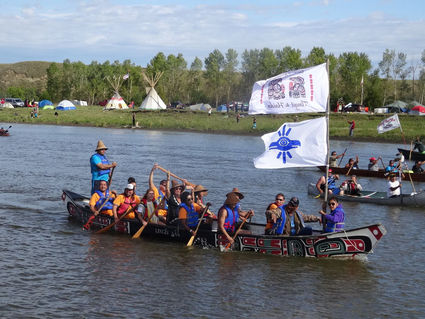Local canoer joins protest in North Dakota

Photo submitted by Prof. Zoltán Grossman
Members of the One People Canoe Society bear the flags of Central Council of the Tlingit and Haida Indian Tribes of Alaska and Sealaska during a canoe run on September 8, showing support for the Standing Rock Sioux in North Dakota. The tribe is protesting construction of an oil pipeline across a sacred burial ground.
A former Wrangell resident joined an Alaska canoe group in supporting a North Dakota tribe protesting construction of an oil pipeline across sacred lands.
Earlier this month Ken Hoyt met up with members of the Juneau-based One People Canoe Society for a three-day spiritual journey on the Missouri River. For a week they joined a growing group of people protesting construction of the Dakota Access Pipeline near tribal land.
The pipeline is planned to be an 1,172-mile connection between the oilfields of North Dakota to southern Illinois. Potentially carrying up to half a million barrels of crude oil per day, the pipeline under construction passes close by the land of the Standing Rock Sioux Tribe, and at some points disrupts traditional burial grounds. Residents are also concerned about pipeline breakages and contamination of the local water supply.
The issue struck a chord with Hoyt, considering similar concerns in Southeast Alaska about Canadian mining operations in development along shared transboundary waters. Hoyt's relatives are from Wrangell, and he considers the community his home. He worked here for SouthEast Alaska Regional Health Consortium's traditional foods program through 2014, when he moved to Idaho. Since January 2015 he has lived there, conducting a similar program for the Coeur D'Alene Tribe.
While in Wrangell, Hoyt was a part of the local Shtax'heen Canoe Family group, and by extension the One People Canoe Society. In November 2014 the Shtax'heen chapter launched its own newly-constructed canoe, a 30-foot model built from fiberglass and cedar.
He has since continued participation in the traditional activity in Coeur D'Alene, with that tribe's own group launching a similarly sized craft this summer.
"They've been going through their canoe movement as well," Hoyt said. In the past year, he said the Idaho group has constructed the large shovelnosed craft and 11 smaller dugout canoes.
Responding to an open invitation by Standing Rock Sioux Tribe chairman Dave Archambault II to come support the movement, Hoyt left for North Dakota with 15 members of the Coeur D'Alene canoe group on September 4. He said they had inspected the river route the week beforehand, and had left a canoe at the camp as a sign of good faith they would return.
Carver and canoe skipper Doug Chilton and other members of the One People Canoe Society were already en route, loading up their distinctive Raven Canoe on a trailer and driving for two days to Fort Rice, North Dakota. There the Alaska group joined canoe societies from four other states, and embarked on a several-hour journey down the Missouri River to Sacred Stone camp.
Near Cannon Ball, North Dakota, Sacred Stone camp is at the epicenter of a local struggle against construction of an 1,100-mile oil pipeline passing through the area. It was set up in April, but protest activity has picked up since mid-August as the issue gained national attention. When they arrived, Hoyt estimated the camp had between 4,000 and 5,000 people living there.
Though they were strangers, Hoyt said the atmosphere at the camp was warmly receptive and had a town-like quality.
"It's really a welcoming and warm vibe around the camp," he recalled. "It's a beautiful land. It's a beautiful territory with beautiful people."
One of the concerns he said friends and family had shared with Hoyt through Facebook was with safety, as images of walls of State Troopers, oil company security guards armed with Mace spray and protesters attacked by dogs circulated online.
"Everyone on Facebook was telling us to be safe," he said. "The truth was we saw plenty of dogs, and they were friendly dogs, with the campers. It's one of the safest places I've ever been."
However, tensions around the camp remained high, and Hoyt worried the group could be dispersed or arrested at any time. "There was that constant threat of bulldozers showing up."
As recently as Tuesday, the Associated Press confirmed at least 22 people protesting at a nearby pipeline construction site were arrested. The Sacred Stone Camp Facebook page reported riot police arrested the group, which included members of the media and support staff.
Tensions locally were also mixed, Hoyt recalled. While he personally experienced no direct intimidation while he was there, Hoyt recalled one instance where the group was paddling down the Missouri River and was caught in a storm.
"It went from sunny to hail in about ten minutes," Hoyt
said.
The canoes headed to shore, and the paddlers sought shelter in a nearby cabin. Hoyt said the owner was accommodating to the group, but mentioned that had they landed even 100 yards away, the neighboring landowner would likely have treated them as trespassers, leading to arrest or possibly worse.
Hoyt made a number of friends while he was there, and said the week was a time to reconnect with his Alaskan people.
"To me the biggest moment was when Doug Chilton told me I did a fine job," he said.
On a broader level, Hoyt saw similarities between the ordeal the Standing Rock Sioux were undergoing and that which the Coeur D'Alene experienced with the contamination of its traditional waters, as well as the ongoing transboundary mining issues closer to his own home.
"It's the same stories for a lot of communities," he said. "We all have some kind of pipeline being built in our backyard, through our sacred water."
Hoyt saw a common cause in the pipeline issue for environmental preservation, and hoped that Alaskans' support today may someday be repaid in kind when it is needed.
"It's easy for us to see ourselves there," he said. "The big thing was that we were making good on an obligation."
The issue in North Dakota remains ongoing, though a move by the Justice, Army and Interior departments on Friday has put construction around the disputed section of pipe on hold.




Reader Comments(0)